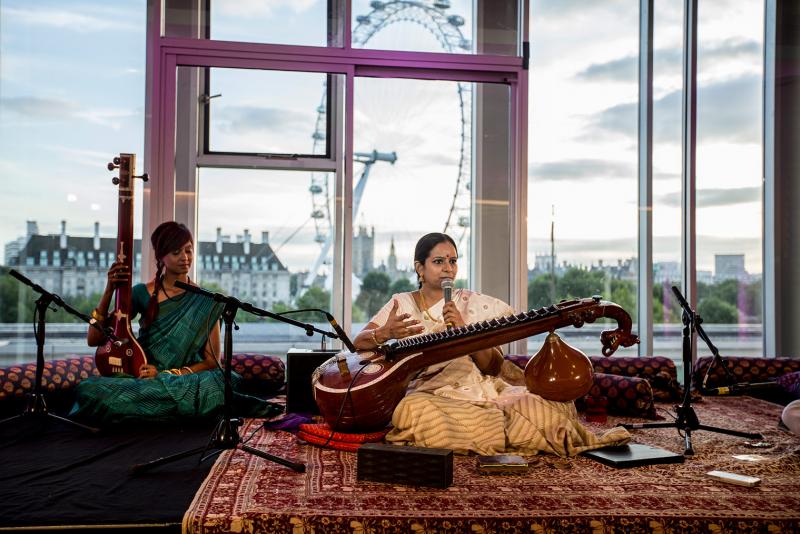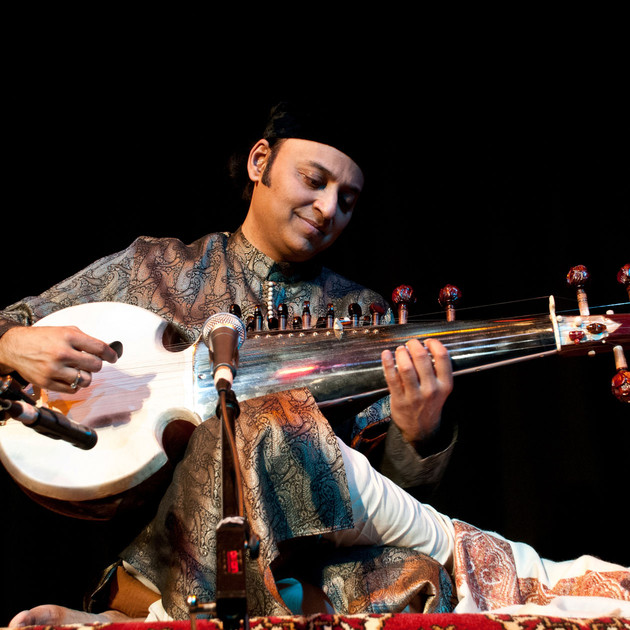Darbar Festival, Southbank Centre | reviews, news & interviews
Darbar Festival, Southbank Centre
Darbar Festival, Southbank Centre
A weekend of extraordinary performances from India's classical music traditions

Darbar Festival, now in its eighth year, encompasses four days of talks, yoga, food, and music – swathes of it, morning, afternoon, and night, with each concert featuring two main sets.This year’s focus was on female musicians, and included a talk featuring the great Carnatic singer Sudha Ragunathan discussing her own experiences and the role of women in Indian music.
Friday and Saturday evening’s concerts focused on Dhrupad, Hindustani and Carnatic music. Dhrupad is the oldest living form of Hindustani (north Indian) classical music, uninflected by Persian and Islamic influences, and with written sources dating to the 15th century, and a much deeper root system connecting to the Vedas, which date to 1500BC.
 Dhrupad vocalist Nirmalya Dey's Friday night performance began slow and rose to life even more slowly, the singer flanked by two female tambura players languidly fingering the same four strings over and over. Dey's eyes are closed, lips almost pursed, his left hand beckoning, his right hand moving up and down to the tal, or pattern of beats. Over the next forty minutes, the first raag manifests with tectonic slowness and hugeness, hypnotically drawing you further in and further. “One music is heard,” he says, "One is unheard, and all music is created from Om.”
Dhrupad vocalist Nirmalya Dey's Friday night performance began slow and rose to life even more slowly, the singer flanked by two female tambura players languidly fingering the same four strings over and over. Dey's eyes are closed, lips almost pursed, his left hand beckoning, his right hand moving up and down to the tal, or pattern of beats. Over the next forty minutes, the first raag manifests with tectonic slowness and hugeness, hypnotically drawing you further in and further. “One music is heard,” he says, "One is unheard, and all music is created from Om.”
Following him is sarod master Ustad Wajahat Khan (pictured above), the youngest in a 400-year-old family lineage. “We have a celestial array of musicians here,’ he remarks jovially, while meticulously tuning his sarod, and gesturing to a formidable front row of Indian maestros. “I tune the instrument,” he adds, “and I tune you too.”
The sarod’s nearest western equivalent is, perhaps, a national steel guitar, though it sounds more like a haunted mansion, with Khan conjuring ‘ghost’ notes or meend (glissandi) with the left hand while his furious, chiming ‘stroke patterns’ with the right hand are his own innovation, forging a propulsive, primordial energy with brilliant tabla player Akram Khan.
Saturday night began with sitar maestro Anupama Bhagwat (pictured below), regarded as one of the finest, most innovative of players. Her second raag, a lengthy intense Alap (solo performance) was extraordinary. She bends and rocks, drops her head close to her instrument, as if imparting its secrets, or hearing them, pulling focus with British tabla star Gurdain Rayatt on different dynamics of the raag. It’s music that flows through you like a seemingly endless range of peaks – a Himalaya of mind and music that suspends all outside distractions, preoccupations and the conventional flow of time.
 Carnatic singer Sudha Ragunathan was introduced as India’s greatest vocalist. “Where words fail, music speaks,” she says, quoting Hans Christian Andersen. “After silence, that which comes to express the ineffable, is music.” Accompanied by mridangam and ghatam, a tambura player, and violinist Jyotsna Shrikanth, this was a superlative, engrossing performance. The percussionists punctuate – defibrillate – the pulse of the music, and the violin shadows and echoes the voice so that they merge into one extraordinarily resonant sound. A Raag imploring Rama to receive the singer into his fold is utterly beautiful and importuning, with its architecture of crescendos, cascades and exultations, and Ragunathan’s extraordinary vocal sustains don’t so much hold the notes as massage them and send them heavenwards.
Carnatic singer Sudha Ragunathan was introduced as India’s greatest vocalist. “Where words fail, music speaks,” she says, quoting Hans Christian Andersen. “After silence, that which comes to express the ineffable, is music.” Accompanied by mridangam and ghatam, a tambura player, and violinist Jyotsna Shrikanth, this was a superlative, engrossing performance. The percussionists punctuate – defibrillate – the pulse of the music, and the violin shadows and echoes the voice so that they merge into one extraordinarily resonant sound. A Raag imploring Rama to receive the singer into his fold is utterly beautiful and importuning, with its architecture of crescendos, cascades and exultations, and Ragunathan’s extraordinary vocal sustains don’t so much hold the notes as massage them and send them heavenwards.
A raag featuring just violin and voice is intensely, ethereally beautiful, and followed by a wonderful solo violin drawing a veil over the quietly churning tambura. This Carnatic vocal music of south India sounds as if it came of age at the dawn of creation, it is that pure and resonant; some ancient race memory sending involuntary shivers down the spine of rapt listeners, a force that corresponds with something very deep in our nature; very fine, very unifying, and very, very old. In terms of the power of the human voice, it cannot, does not, get any better. Search no further - this is the real thing.
rating
Explore topics
Share this article
The future of Arts Journalism
You can stop theartsdesk.com closing!
We urgently need financing to survive. Our fundraising drive has thus far raised £49,000 but we need to reach £100,000 or we will be forced to close. Please contribute here: https://gofund.me/c3f6033d
And if you can forward this information to anyone who might assist, we’d be grateful.

Subscribe to theartsdesk.com
Thank you for continuing to read our work on theartsdesk.com. For unlimited access to every article in its entirety, including our archive of more than 15,000 pieces, we're asking for £5 per month or £40 per year. We feel it's a very good deal, and hope you do too.
To take a subscription now simply click here.
And if you're looking for that extra gift for a friend or family member, why not treat them to a theartsdesk.com gift subscription?
more New music
 theartsdesk on Vinyl 91: Sex Pistols, Pink Floyd, Tropical Fuck Storm, Sparks, The Sisters of Mercy and more
The vastest regular record reviews in the galaxy
theartsdesk on Vinyl 91: Sex Pistols, Pink Floyd, Tropical Fuck Storm, Sparks, The Sisters of Mercy and more
The vastest regular record reviews in the galaxy
 Album: Durand and the Indications - Flowers
Langourous neo-soul to chill by
Album: Durand and the Indications - Flowers
Langourous neo-soul to chill by
 Music Reissues Weekly: The Sonics - High Time
Handsome box set of seven-inchers celebrating the ferocious Sixties rockers
Music Reissues Weekly: The Sonics - High Time
Handsome box set of seven-inchers celebrating the ferocious Sixties rockers
 Album: Benson Boone - American Heart
Retro-Americana, pop-rock sheen, and big-hearted ballads - all with a wink
Album: Benson Boone - American Heart
Retro-Americana, pop-rock sheen, and big-hearted ballads - all with a wink
 Album: Yungblud - Idols
Dominic Harrison’s latest disc fails to live up to the hype
Album: Yungblud - Idols
Dominic Harrison’s latest disc fails to live up to the hype
 Patrick Wolf, Rough Trade East review - the Kent-based bard refashions his new album ‘Crying the Neck’
Despite its record shop setting, this magnetic performance is a show as such
Patrick Wolf, Rough Trade East review - the Kent-based bard refashions his new album ‘Crying the Neck’
Despite its record shop setting, this magnetic performance is a show as such
 Album: Loyle Carner - Hopefully!
Carner takes a deep breath with his latest release
Album: Loyle Carner - Hopefully!
Carner takes a deep breath with his latest release
 Album: HAIM - I Quit
The Californian trio convincingly continue their ascent to the top of the pop-rock tree
Album: HAIM - I Quit
The Californian trio convincingly continue their ascent to the top of the pop-rock tree
 Bonnie Raitt, Brighton Dome review - a top night with a characterful, very American blues rock queen
The US star concludes her UK tour with a rockin' south coast send-off
Bonnie Raitt, Brighton Dome review - a top night with a characterful, very American blues rock queen
The US star concludes her UK tour with a rockin' south coast send-off
 Hidden Door Festival 2025 review - the transformative Edinburgh event's most site-specific festival yet
Art and machinery align in former paper factory
Hidden Door Festival 2025 review - the transformative Edinburgh event's most site-specific festival yet
Art and machinery align in former paper factory
 Pulp, O2 Arena review - common people like us
Jarvis Cocker's mature muse proves ready to follow fans through their lives
Pulp, O2 Arena review - common people like us
Jarvis Cocker's mature muse proves ready to follow fans through their lives
 Sam Fender, St James' Park, Newcastle review - Geordie Springsteen scores with celebratory homecoming
The singer's set was a passionate, emotional display of rock music
Sam Fender, St James' Park, Newcastle review - Geordie Springsteen scores with celebratory homecoming
The singer's set was a passionate, emotional display of rock music

Add comment